(MENAFN- ProactiveInvestors)
By Frank Holmes
CEO and Chief Investment Officer
U.S. Global Investors
It's the start of a new year meaning it’s also time to give your portfolio a tune up and ensure that its engine is running optimally and ready for takeoff. Soaring at 500 miles per hour and looking down from 40000 feet at your portfolio you can more easily visualize where you need to diversify and rebalance.
There may be no one more qualified to help guide you in this exercise than investor behaviorist and asset allocation guru Roger Gibson.
Some of you might have heard of or read the work of Gibson whose seminal piece “The Rewards of Multiple-Asset-Class Investing” is still often cited as one of the best sources on the subject of building a killer portfolio. Though originally published in 1998 its main thesis—that a portfolio made up of multiple asset classes to minimize volatility and capture risk-adjusted reward—is as relevant today as it was 17 years ago.
Before I deep dive into the minutiae of Gibson’s piece I want to share with you a chart last seen in an early December Frank Talk.
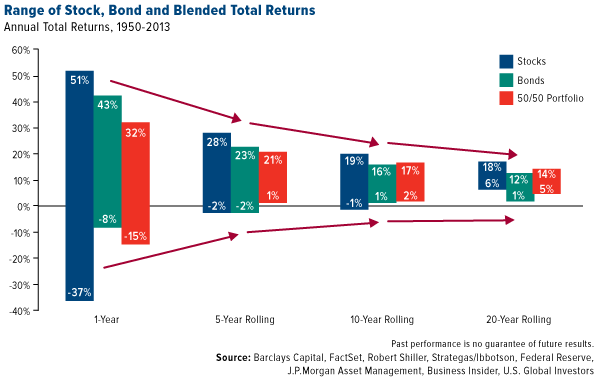
click to enlarge
Using data collected between 1950 and 2013 we can see that the returns of a portfolio composed strictly of stocks have greatly outperformed those of bonds and a blended portfolio in the short term or one-year period. The risks on the other hand have also far exceeded the other two scenarios by a spread of at least 22 percentage points: stocks’ -37 percent versus a blended portfolio’s -15 percent.
But when blended portfolios were held for five 10 and 20 years they began to do two curious things: 1) they gradually outperformed bonds and 2) they demonstrated less risk than stocks. In other words it smoothed out the ride and prevented hitting turbulence along the way.
That’s why savvy investors know to be patient with their holdings and not easily give in to the prevailing culture of instant gratification. I’ve run multiple marathons over the years and am intimately familiar with the personal rewards of going the distance. A similar investing strategy can come with the same rewards.
The chart shown above illustrates what Gibson asserts early on in “Multiple-Asset-Class Investing”:
When we construct an investment portfolio using multiple asset classes we discover that portfolio volatility is less than the weighted average of the volatility levels of its components.
In other words stocks and bonds both have their own unique DNA of volatility but when equally combined the two have tended to balance each other out favorably.
As Gibson colorfully puts it:
The multiple-asset class strategy is a tortoise-and-hare story. Over any one-year three-year or ten-year period the race will probably be led by one of the component single-asset classes. The leader will of course attract the attention. The tortoise never runs as fast as many of the hares around it. But it does run faster on average than the majority of its components a fact that becomes lost due to the attention-getting pace of different lead rabbits during various legs of the race...
Yet the tortoise in the long run leaves the pack behind.
And in case the analogy was lost on anyone the hare is the single-asset-class-domestic stocks for instance-whereas the multiple-asset-class is the tortoise.
This is precisely the point I make in my story “A Little Pillow Talk Turned Her Husband on to Bonds.” To give you the Cliff Notes version Karen 64 years old and retired convinces her husband George 67 to allocate half of their retirement portfolio to domestic stocks the other half to bonds. As a result:
What would have been restless nights for George through [the early 2000s] were moderated by the effect of the short-term muni fund Karen chose. And the great leaps in the S&P 500 that Karen would have missed out on were captured by her husband's 50-percent allocation.
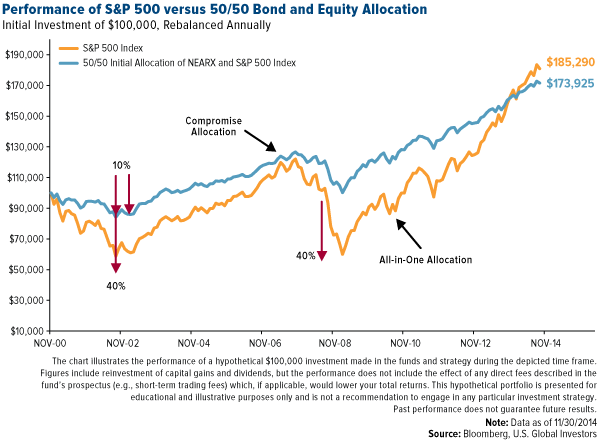
click to enlarge
This hypothetical portfolio illustrates how diversifying into even just two asset classes—our Near-Term Tax Free Fund (NEARX) and an S&P 500 index fund for instance—can result in less volatility. We can’t guarantee how our fund will perform in the future but NEARX has historically shown an ability to dodge the dramatic swings and volatility in the equity market similar to the ones we experienced during the first decade of the century. Of course there will be times when equities like an S&P 500 index fund will strongly outperform the 50/50 allocation to the S&P and NEARX combo but George and Karen’s story is one example of how these two investment strategies have previously performed.
And speaking of municipal bonds the Wall Street Journal reports that they’ve had their best year in approximately two decades posting their “longest string of monthly gains” and “outpacing gains in corporate bonds and U.S. government debt.”
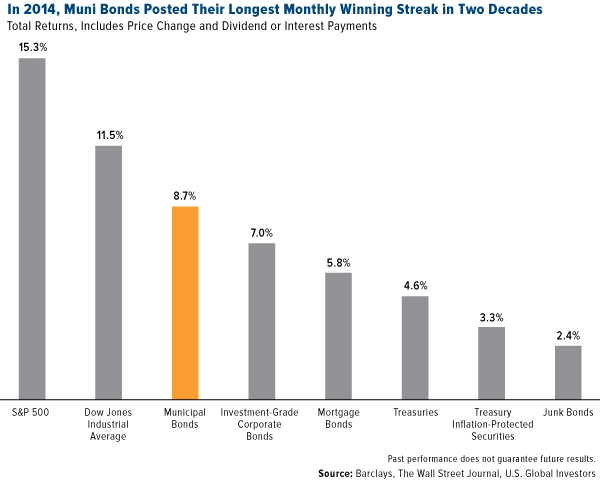
click to enlarge
The Journal writes:
Investors are flocking to the $3.6 trillion municipal bond market at a time of low interest rates uneven global growth and concern that the nearly uninterrupted rise in many stocks and bonds since the financial crisis will come to an end. The debt is especially attractive because interest payments typically don't generate federal taxes and in some cases aren't subject to state taxes.
Multiple Asset Classes and the Magic of Mean Reversion
The graph below taken from Roger Gibson’s own research is the result of tracking nearly 40 years’ worth of market data. He looked specifically at four asset classes: U.S. stocks foreign stocks commodities and real estate securities. He then examined what happened if you steadily blended these equities.
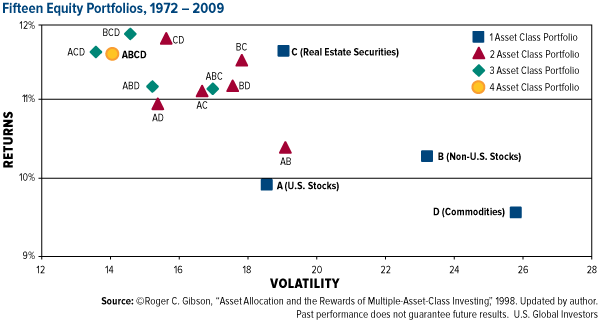
click to enlarge
You can see the historical risks and rewards of 15 different types of equity portfolios Gibson assembled—four composed of a single asset (the blue squares) six composed of two assets (the red triangles) four of three assets (the green diamonds) and one containing all four assets (the yellow circle).
With one exception—real estate securities (C)—the portfolios that contained only one type of asset class tended to offer the least amount of annualized returns and pose the greatest volatility. When you blended the equities—two at a time three at a time and then all four—both the returns and standard deviations improved. The yellow circle (ABCD) which makes use of all four asset classes ranked as one of the least volatile most rewarding portfolios.
What’s amazing is that the most volatile asset class commodities (D) helped constitute the very top-performing portfolios: ACD BCD CD and ABCD. Again this demonstrates Gibson’s point that “portfolio volatility is less than the weighted average of the volatility levels of its components.”
Or put another way:
For investors concerned primarily with maximizing portfolio returns we see that multiple asset-class strategies have dominated single-asset-class strategies.
Just as you must have discipline to pace yourself and complete a marathon it takes discipline to regulate and manage your emotions while rebalancing your portfolio. It only makes sense to pivot into asset classes that are reverting to their mean in order to catch the upside. This is a subject I touch upon in my whitepaper “Managing Expectations.”
The Case for Active Management and Contrarian Investing
One final point I want to make involves active management. You might have heard that investors are increasingly placing their money in exchange-traded funds (ETFs) which in many cases have delivered excellent returns. But a recent piece in InvestmentNews makes the case that active management such as what we use for our mutual funds is indispensable going into 2015.
We’ve experienced an equity bull run for half a decade now so it’s easy to presume that an index fund will be able to catch all the upside. But what about the downside A correction is likely to occur at some point. As opposed to an index fund active management helps to curtail volatility such as what we’ve seen lately in certain sectors such as commodities and emerging markets and mitigate risk.
“The idea is there will be benefits of investing with active managers as we get along in the market cycle and the possibility of downturn seems stronger” says John Rekenthaler vice president at Morningstar.
A perfect example of this is our exit from Russia. The benchmark of our Emerging Europe Fund (EUROX) the MSCI Emerging Markets Europe 10/40 Index maintains a 46-percent weighting in Russia. But because of prudent active management we were able to divest out of Russia and avoid many of the downturns incurred by international sanctions falling oil prices and a weakening ruble.
The European slowdown has received much attention in my own blog and elsewhere but there are still plenty of investment opportunities. Another recent piece byInvestmentNews in fact finds that “European ‘quality growth’ companies which include euro-area and non-euro-area firms are trading at a significant discount to their small-cap peers in other regions.” Additionally the writers’ analysis “suggests that European companies have the most potential to improve returns… as a more sustainable European recovery takes hold.”
Indeed several European businesses are making admirable strides. Names we own that pay a dividend include Italy’s UniCredit and Brembo and Switzerland’s Straumann Holdings. Poland has also been good to the fund. For 2014 Energa SA had a 12-month dividend yield of 4.3 percent; PKO Bank Polski 2.1 percent; and insurer PZU Group 7.05 percent.
Take a look at the chart to the right. What it shows is that Polish equities indicated by the WIG20 Index are not only cheaper than U.S. equities right now—by nearly a quarter percent—but they also pay out twice the dividend yield. Simply put you’re getting more for less.
Additionally Tom McClellan editor of the McClellan Market Report offers three clues as to why the “Euro Is Ripe for an Upturn” one of which is that :
The beginning of a new calendar year usually sees some kind of reversal of the existing trend in the euro... The February 1 2013 top was a much later than normal manifestation of this behavior; usually the reversal is closer to New Year's Day.
Keeping It Diversified
You might wonder if Roger Gibson’s research still holds up after all these years especially following the market meltdown that was the Great Recession. As recently as two years ago Forbes contributor Gregg S. Fisher revisited the multiple-asset-class investing strategy with fresh data and found that it indeed still makes for a souped-up portfolio.
“In an industry prone to fads” Fisher writes “thoughtful portfolio diversification is an investment strategy that stands the test of time.”
The good news is that highly-liquid M2 money supply growth has quickened up around 5 percent from a year ago. Historical trends have shown that rising money supply has been good for stocks.
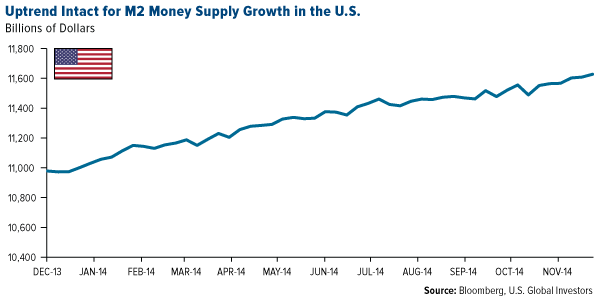
click to enlarge
Now's the time to rebalance and ignite your portfolio's jet thrusters. Let's make 2015 a prosperous year!
Total Annualized Returns as of 9/30/2014 | | One-Year | Five-Year | Ten-Year | Gross Expense Ratio | Gross Expense Ratio After Waivers |
| Near-Term Tax Free Fund | 3.26% | 2.59% | 2.97% | 1.21% | 0.45% |
| S&P 500 Index | 19.72% | 15.68% | 8.10% | NA | NA |
Expense ratio as stated in the most recent prospectus. The expense ratio after waivers is a contractual limit through December 31 2015 for the Near-Term Tax Free Fund on total fund operating expenses (exclusive of acquired fund fees and expenses extraordinary expenses taxes brokerage commissions and interest). Performance data quoted above is historical. Past performance is no guarantee of future results. Results reflect the reinvestment of dividends and other earnings. For a portion of periods the fund had expense limitations without which returns would have been lower. Current performance may be higher or lower than the performance data quoted. The principal value and investment return of an investment will fluctuate so that your shares when redeemed may be worth more or less than their original cost. Performance does not include the effect of any direct fees described in the fund's prospectus which if applicable would lower your total returns. Performance quoted for periods of one year or less is cumulative and not annualized. Obtain performance data current to the most recent month-end at www.usfunds.com or 1-800-US-FUNDS.
Index Summary
- Major market indices finished lower this week. The Dow Jones Industrial Average fell 1.22 percent. The S&P 500 Stock Index dropped 1.46 percent while the Nasdaq Composite declined 1.67 percent. The Russell 2000 small capitalization index fell 1.35 percent this week.
- The Hang Seng Composite rose 2.18 percent; Taiwan gained 1.01 percent and the KOSPI declined 1.11 percent.
- The 10-year Treasury bond yield fell 13 basis points to 2.12 percent.
Domestic Equity Market
The S&P 500 Index pulled back this week falling 1.46 percent after hitting new highs the prior week. After a phenomenal run in recent months utilities were the worst performer for the week falling close to 3 percent. Although every sector fell this week energy was the best performer. This movement is interesting since oil prices continued to fall.
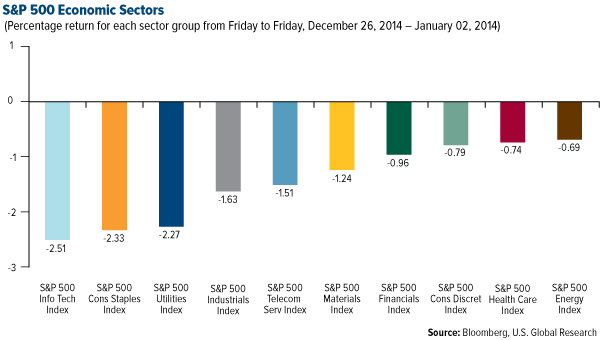
click to enlarge
Strengths
- Energy stocks were the best performers for the week rebounding from recent underperformance. Refiners were among the leaders as Marathon Petroleum and were both positive for the week.
- The health care sector was a close second this week; Laboratory Corp. of America and were among the leaders on an analyst upgrade. also bounced back this week after last week’s brutal selloff.
- The consumer discretionary sector also outperformed this week. Retailers and homebuilders dominated the best-performers list including Macy’s Gap and . Homebuilders and Pulte Group were also strong performers likely driven by better consumer confidence data.
- was the best-performing company for the week rising 3.94 percent. The company continued to make headway with its Cystic Fibrosis drug moving the group closer to reaching its long-term financial goals.
Weaknesses
- The technology sector was the worst performer this week as fell by more than 4 percent. Other index heavyweights such as and also came under selling pressure for the week.
- The utilities sector underperformed this week in a broad-based sell off after a very strong run.
- The worst performing company this week was Southwestern Energy falling 5.23 percent. The company is in the middle of acquiring additional assets in Appalachia and needs to complete a dilutive equity raise in the near future to fund the purchase. This comes in addition to weak natural gas prices which has put natural gas producers under pressure recently.
Opportunities
- Financial stocks have been among the best performers over the past month and are showing signs of relative strength. This likely can be attributed to a flattening yield curve that should help banks and insurance companies as we move through 2015.
- With gasoline prices continuing to fall consumer discretionary and consumer staples sectors stand to benefit in the weeks and months ahead.
- If oil can find a bottom and move higher small- and mid-cap energy stocks would be among the first beneficiaries.
Threats
- The rally of U.S. energy producers may be short lived as OPEC countries seem to be acting individually rather than as a collective cartel making any prediction of future actions more difficult. However this will be positive for the inverse beneficiary companies in sectors such as airlines and consumer discretion.
- The European Central Bank (ECB) has still not shown its cards on any plans to revive the European economy. If the ECB plays a weak hand Europe could end up in recession again.
- The broader equity market has been surprisingly tame over the past year and a 10-percent correction would be nothing out of the ordinary.
The Economy and Bond Market
U.S. Treasury bonds rallied this week sending yields lower across the curve. Comments from ECB President Mario Draghi acted as a catalyst on Friday when he said the risk of deflation in Europe can’t be ruled out. This sparked a rally in European bond issues sending the German five-year note into negative territory. U.S. issues followed suit. One counter point and an interesting development in Europe is what appears to be a bottoming in eurozone manufacturing purchasing managers’ index (PMI) data. This would be a significant positive development after declining data came in for most of 2014.
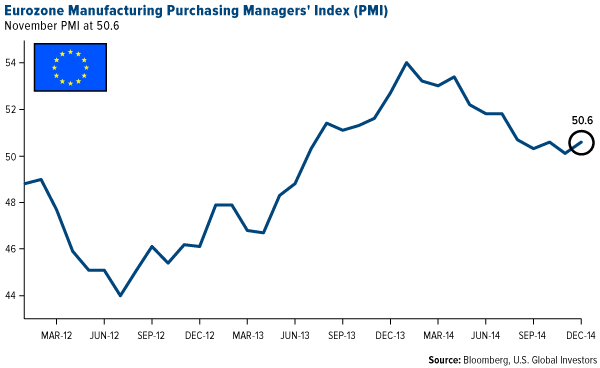
click to enlarge
Strengths
- Consumer confidence bounced back in December toward recent highs. Falling gasoline prices and improving job prospects were key drivers.
- Housing data was better than expected with prices improving and pending home sales rising 0.8 percent in November.
- As mentioned above eurozone manufacturing PMI is showing some improvement while much of the rest of the world is still trending lower.
Weaknesses
- December manufacturing ISM for the U.S. fell to 55.5. While the absolute level indicates strength the trend is lower and the recent fall in energy prices may be a boon for consumers with potential to negatively reverberate through the manufacturing sector of the economy.
- China’s official PMI fell to 50.1 and continues to suggest weaker growth prospects from the country.
- Greece will hold early “snap” elections later this month raising the possibility of a “Grexit” from the euro which could cause many unforeseen consequences.
Opportunities
- The ECB chose not to act recently leaving the door wide open to full-blown quantitative easing (QE) in the first quarter of 2015.
- Short-term bond yields have risen. However with many headwinds to raising interest rates the may not be able to follow through on the threat of interest rate increases in 2015 presenting an opportunity. This is a very similar scenario that played out a year ago.
- Municipal bonds continue to look like an attractive alternative in the broad fixed-income universe.
Threats
- Greece is generating negative headlines again and while it appears to be an isolated political event it does reinforce the idea of the fragile nature of the euro currency.
- Oil prices appear to be extremely oversold and even a bounce in oil could change the mood in the market with a potential sell off of bonds in reaction.
- After rallying this week a strong unemployment report coming out next Friday has the potential to quickly change sentiment.
Gold Market
For the week spot gold closed at $1187.88 down $8.12 per ounce or 0.68 percent. Gold stocks as measured by the NYSE Arca Gold Miners Index gained 3.72 percent. The U.S. Trade-Weighted Dollar Index rose 1.20 percent for the week.
| Date | Event | Survey | Actual | Prior |
| Dec 29 | HK Exports YoY | 2.3% | 0.4% | 2.7% |
| Dec 30 | US Consumer Confidence Index | 94.0 | 92.6 | 88.7 |
| Dec 30 | HSBC China Manufacturing PMI | 49.5 | 49.6 | 49.5 |
| Dec 31 | US Initial Jobless Claims | 287K | 298K | 280K |
| Jan 02 | US ISM Manufacturing | 57.5 | 55.5 | 58.7 |
| Jan 05 | German YoY | 0.3% | - | 0.6% |
| Jan 07 | Eurozone Core YoY | 0.7% | - | 0.7% |
| Jan 07 | US ADP Employment Change | 225K | - | 208K |
| Jan 08 | US Initial Jobless Claims | 290K | - | 298K |
| Jan 09 | US Change in Nonfarm Payrolls | 240K | - | 321K |
Strengths
- Gold traders surveyed by Bloomberg are bullish for next week. Rising concerns surrounding the political uncertainty in Greece are increasing the precious metal’s appeal as a haven.
- set its long-term forecast for gold prices at $1200 an ounce for the next three years. This price is estimated by the investment bank to be the majority of gold producers’ breakeven price. If gold prices fall below $1200 an ounce losses would result in a supply reduction which should prop prices back up.
- China’s net gold imports from Hong Kong reached a nine-month high in November most likely due to inventory build-ups for the Lunar New Year. Furthermore the Shanghai Gold Exchange saw strong withdrawals last week at 57.7 tons bringing the year to date total to 2073 tons.
Weaknesses
- Gold ended 2014 slightly down declining 1.72 percent. This is the second-straight year that gold has declined.
- The drop in gold prices this year is affecting coin sales. The U.S. Mint is heading for its biggest annual decline in sales since 2006.
- Gold-backed ETFs are seeing the negative effects of lower gold prices as well. Holdings in gold-backed ETFs dropped to the lowest level since 2009 as roughly $6.7 billion was removed this year.
Opportunities
- Gold prices responded positively to news last Friday that China’s central bank was considering loosening liquidity requirements for the country’s banks. With many seeing this speculation becoming reality news of further stimulus in China should cause a further rise in gold prices.
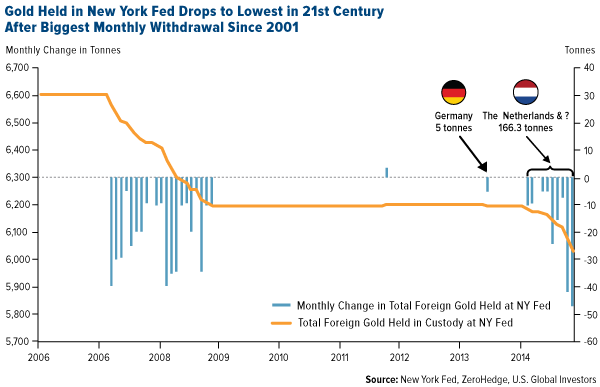
click to enlarge
- The New York recently saw a 42 ton withdrawal of gold. The recent rise in gold repatriation from countries like the Netherlands and Germany is a sign that global market and political uncertainty is on the rise and gold is becoming increasingly valued as a haven asset.
- German five-year yields on government bonds dropped below zero this week for the first time. The difficulties facing Europe are captured in this event as investors are now willing to pay to hold German debt with no returns. With falling rates and growing uncertainty gold becomes an increasingly valuable alternative asset.
Threats
- Chilean President Michelle Bachelet presented a bill this week that would make union leaders the only authorized negotiators in wage bargaining while outlawing mining companies’ rights to replace workers on strike. The proposal will risk further investment delays according to the mining companies affected.
- The Zambia Mines Minister is refusing to undo the hike on mining royalties that came into effect on January 1. The policy raises royalties for open pit mines from six percent to 20 percent.
- The Chilean Supreme Court declined to hear Corp.’s appeal regarding fines imposed on its Pascua-Lama project. The fines imposed by the country’s environmental regulator could make it more difficult to move the project forward.

Legal Disclaimer:
MENAFN provides the information “as is” without warranty of any kind. We do not accept any responsibility or liability for the accuracy, content, images, videos, licenses, completeness, legality, or reliability of the information contained in this article. If you have any complaints or copyright issues related to this article, kindly contact the provider above.